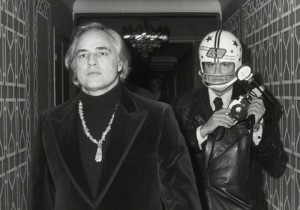There was a time when paparazzi and stars were predator and prey, but it’s more complicated now.
Deals are struck, contracts signed, and a paparazzo is hired to “stalk” a star to assure a Q rating remains copacetic. Sometimes a tabloid photographer does get a scoop, an embarrassing one, but these are free-marketers, not muckrakers, and they’ll gladly sell the photos back to the celebrity if they’re willing to pay more than the press. The two sides are in predetermined cahoots or open to such an ad-hoc arrangement, the idea that famous people can’t get away with what they used to, overstated. Those who get caught with their pants down are mostly pols and celebs dense enough to text their own incriminating images to strangers.
Alex Mayyasi of Priceonomics acknowledges some of these points but has a different take. The opening:
Before John F. Kennedy’s assassination in 1963, the handsome, young president had a public image as a doting father and as the man who called Americans to public service. In his private life, he was a serial adulterer. Historians have all but confirmed Kennedy’s involvement with women ranging from Marilyn Monroe to two White House interns who skinny dipped in the presidential pool and flew on Air Force One so that, as Caitlin Flanagan puts it in The Atlantic, “the president could always get laid if there was any trouble scaring up local talent.”
If a current president acted like Kennedy, reporters from every paper would seize on rumors until his presidency ended in shame. But the early 1960s were a different time; the American public remained ignorant of Kennedy’s affairs because no one reported on them. In his biography of Kennedy, Robert Dallek writes that Kennedy “remained confident that the mainstream press would not publicize his womanizing.” Even more incredible than the press’s self-imposed censorship is Dallek’s observation that when gossip columns began speculating about JFK and Marilyn, he sent a friend and former journalist to “tell the editors… that it’s just not true.” Apparently it got results.
After the JFK assassination, Jackie Kennedy lived in New York. She remained in the public eye as a fashion icon and as the widow of the fallen president, but she harbored no great secrets. Nevertheless, a Bronx resident by the name of Ron Galella would not leave her alone. Galella followed Jackie Kennedy Onassis incessantly, snapping pictures of her around the city and leading the former first lady to go to court to win a (largely ineffective) restraining order against Galella.
‘Today famous figures endure the Galella treatment on a regular basis. Galella is the progenitor of the modern paparazzo who takes pictures of celebrities “doing things,” as he puts it, which is now so common that photographers struggle to get a good picture of Brad Pitt grabbing takeout because so many other paparazzi are crowding him to get a shot.
The proliferation of media devoted to covering famous figures, omnipresent paparazzi, and a change in the culture of how we treat celebrities — from adoring them from a distance to seeking both familiarity and the exposure of all their secrets — has led to an increase in the price of fame. Whereas Kennedy could trust the press not to expose his affairs, modern celebrities must design their lifestyle around avoiding cameras whenever they eat out. Over time, the public has come to expect a certain amount of transparency around famous people’s personal lives. We are all paparazzi now.•
Tags: Alex Mayyasi

